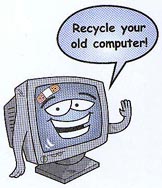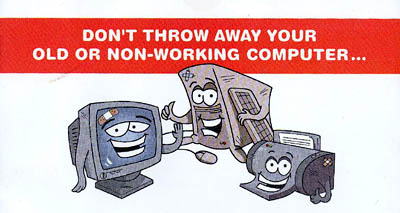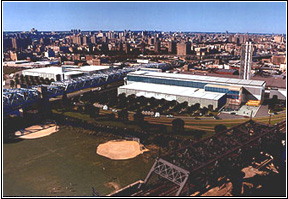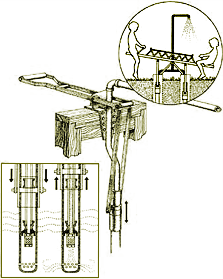recycle
Words in Print
Just when you’re pounded by clients and far too busy to think about updating your blog, Print magazine publishes a nice little write-up pointing readers your way:
“Most designers agree, even insist, that design is more than clever imagery selling goods and services — it also influences how societies function. Social Design Notes, a remarkably informed and highly useful blog edited by John Emerson, explores design’s sociopolitical power and inspiration. A New York activist and designer who oversaw Web sites for Amnesty International USA and Human Rights Watch, Emerson launched his blog is 2002 as a ‘bridge between design activism — to push designers to think about acting in the public interest and to help activists see how design can facilitate their campaigns.’ Emerson explores how design is used to support and challenge the status quo, posting one historical note about the ‘Black Panther Coloring Book’ created by the FBI during the civil-right movement, and another about South Africa’s use of the comic book to prepare its citizens for their first election. Emerson also discusses the built environment, praising former New York mayor Rudolph Giuliani for having championed design to improve the lives of the disabled. And Social Design Notes’ Resource page contains tools — such as free stock photos — designed to convert readers into true reformers.”
The July/August 2005 issue also has a several excellent articles on sustainable design, and is worth checking out for this alone.
But it makes you wonder — why doesn’t the magazine itself use recycled paper? Despite the “In Print” column which touts the magazine’s “early environmental outlook,” this is not addressed. So, do they care about sustainability or not? I know design magazines are hardly a lucrative venture, but the article “Fiber Optimistic” on page 57 points out that cost differences between recycled paper and not are nowadays “negligible.”
But then why not take it a step further. If toxic printing processes and non-recycled paper are harmful to the environment, why not consider sustainability as a criteria for your annual design competition?
Imagine what a massive force the AIGA could be if they required printed entries to their annual showcase use recycled paper.
Would this punish designers for the choices of their clients? Perhaps, but then why shouldn’t judging the beauty of a product take into account the nature of physical object itself? If designers care about competitions, why shoudn’t they push their clients that much harder? Why don’t all design competitions consider sustainability as a criteria? Does this impose some kind of “political” viewpoint? One could argue that not requiring this broadcasts a political viewpoint just as clearly.
Would the AIGA’s dues paying members revolt? Certainly some, but as the issue of Print notes (p. 11):
“This year the AIGA formed a national task force to develop policies and programs for the organization in support of sustainability. Following a poll revealing the environment to be the profession’s most pressing concern, the Worldstudio Foundation and the AIGA, through their ‘Design Ignites Change’ collaboration addressing social issues on a local level, made sustainability the focus of their first project.”
Hell, the AIGA’s last national conference was largely devoted to discussion of sustainability.
So at what point does sustainable design cease to be a “special issue”? When does it become incorporated as a fundamental part of what we do? And when do our design institutions take a stand and show some leadership? When do we start demanding it?
Is this all unreasonable? I would point out that it’s already happened once before. The American Institute of Architects, another national design association, went through a very similar internal debate years ago and came out embracing the green.
...
Update July 18, 2005 — Print responds:
“It’s true, Print does not currently use recycled paper, but we are looking into doing so as soon as our current supply of paper is fully depleted. It has been an economic issue in the past, but we are hoping to persuade our publishers to spend a little extra on this aspect of responsibility.”
Gebührensäcke
 As the UK evaluates its waste reduction programs, five BBC correspondents file a nice little collection of vignettes on the state of waste reduction and recycling around the world.
As the UK evaluates its waste reduction programs, five BBC correspondents file a nice little collection of vignettes on the state of waste reduction and recycling around the world.
Of note is Switzerland’s garbage tax sticker:
“The Swiss do not recycle just because they care about the environment. There is a strong financial incentive. Recycling is free, but in most parts of Switzerland throwing away rubbish costs money — each rubbish bag has to have a sticker on it, and each sticker costs at least one euro (60 pence).
So the less you throw out, the less you pay. No sticker? Then the rubbish will be left outside your house to rot.”
The snapshots are all too brief (and a little more anecdote than analysis) but leave me hungry for more.
.....
June 29, 2005 — Reader Jim R. writes:
“Being a country of ‘participative democracy’ in almost the extreme sense of the word, the Swiss get to vote, a few times a year, on many topics both of great and little significance. The federal government leaves the cantons with a lot of power. One thing the cantons can vote on is how they want to handle garbage collection. Last year sometime we had an initiative on Gebührensäcke.
I live in canton Vaud, and at the time garbage collection was paid for out of our local taxes. We voted as to whether we should switch to paying more for garbage bags (in lieu of a sticker), which would cover at least some of the costs of garbage collection. The initiative failed. The two main arguments against were:
1. Certain costs should be shared equally by everyone, regardless of family situation. Therefore a single person should pay (roughly) the same for garbage as a family. Swiss Socialist tendencies, perhaps?
2. Opponents warned of "garbage tourism" where people would drop their garbage bags over the border in the next canton.
A trickster might just drop off his garbage bag somewhere along the road late at night. But beware: Sometimes the authorities will go through the garbage, looking for an address or something else that will incriminate the perpetrator. But I think that happens more in the German part than here in the French part.
Yes, the Swiss are pretty damn good at recycling compared to other countries in Europe. And let’s not even talk about the States... But there’s still plenty of room for improvement here.”
Electronics Recycling in NYC
If there are regular readers of this site out there, you might be interested in the results of the NYC electronics recycling events I blogged about in October.
 Andriana Kontovrakis, Project Manager at the NYC Department of Sanitation writes:
Andriana Kontovrakis, Project Manager at the NYC Department of Sanitation writes:
“We collected 52 tons (104,000 pounds) of obsolete computer materials from more than 1,000 people this past Fall. The material was collected through 8 one-day collection events held between October and December.
We are happy with the turnout and tonnage. This was the first time DSNY held electronics recycling events, so we did not have a pre-set goal. We are assessing how and when we might possibly hold such events in the future, but we do not currently have any events planned.”
Independent of city sponsorship, grassroots groups continue to hold electronics collection events around town.
I just missed yesterday’s Recycle This! and Per Scholas event at Grand Army Plaza in Brooklyn.
On April 17, 2005 from 9 am to 5 pm, the Lower East Side Ecology Center will collect electronics in the North Plaza of Union Square Park.
Silicon in the Naked City

Last week, I was delighted to receive a piece of mail from the New York City Department of Sanitation.
The flyer announced a series of events around the city to collect, refurbish, and recycle old electronics in an environmentally responsible manner.
Electronic devices constitute less than one percent of the NYC waste stream, but the materials are extremely toxic if not disposed of properly.
I know non-profit and volunteer groups hold collection events from time to time, but I almost always find out about them after the fact. The refurbished computers are usually donated or sold to low-income families, schools, and community groups for a nominal fee.
This time, however, the Department of Sanitation itself is sponsoring events in the five boroughs to collect e-waste. Working cell phones are being donated to Collective Good.
The events are jointly funded by Dell and Lexmark and the National Recycling Coalition. The Lower East Side Ecology Center and other community groups are coordinating.
I asked Robert Lange, New York City’s Director of Recycling and Waste Prevention about the events:
SDN: Was this started at the initiative of the City, local groups, or manufacturers?
 Click to view a larger version |
I usually find out these things after the fact. What kind of outreach are you doing?
We sent out the flyer well in advance to every residence in the city, and posted the information on our Web site.
Is this aimed primarily at consumers or businesses or both?
It is aimed at city residences.
Will there be a similar push directed at businesses?
It’s possible.
In things like this, it depends on who picks up the tab. Does the tab get picked up by the businesses that profit from the manufacture and sale of these items? Is the tab picked up by consumers? Is some ways, ultimately, the tab is always picked up by the consumer, either directly associated as a charge with the item when they by it, or indirectly through a tax, to run a municipal program, for example.
In my own estimation, because there is an infrastructure for producing these things and delivering the products to people, it makes sense to use the same distribution network to take them back if possible.
And to some extent, Dell and other manufacturers are doing that. If you look at the flyer or the Web site, there are services currently provided by these companies for taking back computers. In some cases, there’s a nominal charge, in other cases there’s no charge, but it’s services they provide to directly take back computers from consumers after their useful life.
Given the toxicity of materials, is there a chance that the disposal may be regulated legislatively?
There are materials like this in the waste stream that are increasing in volume and they need to be addressed. Whether they need to be addressed by a municipal program or not is something that is still in question.
There are a variety of proposed pieces of legislation, both in our area and in other parts of the country to require that this material be handled in a more responsible manner. Different legislators have different perspectives on who picks up the tab.
My own opinion is that this is something that manufacturers should really be required to deal with. And to some extent they are stepping up to the plate because the funds for these drop-off programs that we are running through community-based organizations are being provided by Dell and Lexmark.
 I don’t know if you are familiar with an organization called RBRC which is for taking back batteries — particularly Nickel Cadmium batteries. It is funded and run by the battery industry. A few years ago, when the industry was facing the potential of severe regulation governing how batteries could be disposed of, all the manufacturers got together set up an informal network to receive batteries from the public. All the Radio Shacks, Staples, and organizations like that take back batteries from the public as part of the network they established. And they did that try to avoid the kind of regulation that was coming down.
I don’t know if you are familiar with an organization called RBRC which is for taking back batteries — particularly Nickel Cadmium batteries. It is funded and run by the battery industry. A few years ago, when the industry was facing the potential of severe regulation governing how batteries could be disposed of, all the manufacturers got together set up an informal network to receive batteries from the public. All the Radio Shacks, Staples, and organizations like that take back batteries from the public as part of the network they established. And they did that try to avoid the kind of regulation that was coming down.
I think the computer industry has an even greater incentive to do that, so I expect that what is now fairly informal will become a more formal network in the future. Either that or there will be legislation passed.
What are your future plans?
This is something of an experiment. As I said, the funds are being provided by Dell and Lexmark. Whether they will continue to provide funding... they have not made a long range commitment to that effect.
The collections will run through the fall. How we go forward will depend on the amount success we have. Events like this have been run in the City before and the average tonnage of computers and electronics received per event is approximately 10 tons. We hope to see exponentially higher numbers because this mailing is going to every household in the City.
For more information, visit the NYC Wasteless Web site.
...
And while we’re talking trash, big up to the Mayor for his plan to ship waste from Manhattan’s 59th Street pier instead of trucking it to Brooklyn and the South Bronx.This should relieve some of the burden from low-income neighborhoods who overwhelming suffer the traffic of the City’s trash.
NYC Recycles Glass Again
In case you missed it, yesterday Mayor Bloomberg and the Sanitation Commissioner announced that the City will resume recycling glass and return to weekly recycling collections on April 1.
Glass and plastic recycling was suspended in July 2002 as a “cost-cutting measure.” It turned out that mixing recyclable materials with the regular waste stream did not actually save much money. And, when they found out that others were willing to pay for the City’s recyclables, the City resumed the collections. Bi-weekly plastic recycling resumed July 2003.
See this previous blog post from July 2003.
Huzzah!
Bronx Community Paper Company
In the Internet Archive, the javascript ticker still scrolls “Recycling Community Improvement Water Conservation Job Creation Economic Development Brownfield Reclamation,” beneath the former Web site:
“The Bronx Community Paper Company (BCPC) — a joint project of the Bronx-based Banana Kelly Community Improvement Association and the Natural Resources Defense Council is an innovative effort to harness New York City’s ‘urban forest,’ which includes the 1.2 million tons of paper the city throws out every year, by building a paper de-inking and newsprint production facility in the city....
The end result will achieve several important objectives: creation of hundreds of long-term jobs; reduction of the City of New York’s costs for disposing of wastepaper; revitalization of an abandoned industrial tract in the inner city; and protection of forests....
Throughout the development process, the BCPC kept the public continually informed on the project’s progress. In fact, during the environmental licensing process, the BCPC held over 120 public meetings with members of the South Bronx community, although by law a developer is only required to hold one...
 With all legal, political and environmental issues behind them, only two major tasks for the BCPC remain — securing a deal with a paper company to operate the plant, and, of course, building the mill.”
With all legal, political and environmental issues behind them, only two major tasks for the BCPC remain — securing a deal with a paper company to operate the plant, and, of course, building the mill.”
Facilities for the BCPC were to be built on the Harlem River Rail Yard, a brownfield site requiring environmental remediation. The mill was to produce 2,200 jobs during construction and more than 600 permanent full-time jobs during operation.
In 1997, the Department of Energy posted a glowing review of the project as a “sustainable business success story”:
- The manufacturing facility will be an integrated recycling paper mill, including a wastepaper de-inking plant, a newsprint paper making machine, a wastepaper sorting plant and a steam boiler.
- The project will advance the market for economically viable recycling of 100% post-consumer, totally chlorine-free paper.
- The mill will serve as a solid waste alternative for a city recently proposing to build seven large waste incinerators.
- The paper mill will enable a major paper-making company to use secondary fibers for the manufacture of its newsprint, a commodity that is now manufactured mostly with virgin timber.
- The Harlem Rail Yard, an abandoned industrial facility in an out-of-use rail yard, will serve as the site of the mill. An additional goal of the project is to redevelop the rails, which will then serve as a transportation corridor for materials to and from the facility.
- The project will pioneer the use of water from a reclaimed sewage wastewater treatment plant, keeping water costs one-third lower than comparable fresh water.
- A comprehensive air study of the South Bronx was initiated to ensure technologies will be implemented to reduce to the greatest extent possible all emissions from the facility.
- The project will incorporate innovative energy-efficient technologies not implemented in any other paper mill in the country.
- The mill will utilize a chlorine-free de-inking technology that produces no air emissions or odors.
- Maya Lin, designer of the National Vietnam Memorial in Washington, DC, will design the facility’s layout and structure.
Banana Kelly was founded in 1977 when thirty residents gathered to stop the demolition of their homes along Kelly Street, a crescent shaped block in the heart of the Longwood/Hunts Point neighborhood of the South Bronx. Without support, tools, money, title to the property, they succeeded in rehabilitating the buildings and in creating 21 units of high-quality affordable housing. The activists formed the Banana Kelly Community Improvement Association, Inc. to continue the work that they had started. Since 1978, the organization has rehabilitated, weatherized, and managed thousands of housing units, provided service referral and housing advocacy, conducted education and job training, and attracted the first new health care clinic in the community in 22 years.
Revenue from the Bronx Community Paper Company was to fund other community development projects in the neighborhood, including:
- The Bronx Dormitory Project. A joint venture between Banana Kelly and Bronx Regional High School that will provide shelter for up to 20 students attending the high school who do not have stable living arrangements.
- The South Bronx Family Learning Center. A proposed 35,000-square-foot center that will include health care, child care, literacy classes, employment and training centers and housing opportunities.
- The Prospect Corridor Commercial Development Project. This project will promote local economic development by connecting existing and planned residences with a retail strip on Prospect Avenue.
- The Library Project. A project to increase the availability of library services in the South Bronx by providing additional equipment, supplies and materials to local libraries.
- Business and Housing Revolving Loan Fund. This project will provide a pool of working capital to be used by small entrepreneurs to purchase inventory, equipment or supplies to meet their contractual obligations and expansion needs. The fund will concentrate its services on housing groups that require basic repairs or replacement of major systems in their buildings.
- The Children’s Endowment Fund. To be administered by Banana Kelly, this fund will enhance and expand the educational and vocational opportunities available to children.
But by 2000 the project had folded.
From The New York Times, August 17, 2003
‘Bronx Ecology’: Green, Rocky Road
 “In 1992, Allen Hershkowitz, a senior scientist with the Natural Resources Defense Council, proposed building a paper mill in the South Bronx. It would harvest the immense amount of wastepaper (used newspapers, junk mail, office detritus) New York City generates each day, recycle it into newsprint using ecologically sound methods and sell the product to local consumers, notably newspapers. Such a mill would address two city woes: the continuing slump, particularly severe in places — like the South Bronx — long dependent on the shrinking manufacturing sector (joblessness there hovered around 20 percent, 50 percent for teenagers); and the loss of traditional outlets for the city’s waste stream (ocean dumping, hauling to putrid landfills and burning in dioxin-spewing plants).
“In 1992, Allen Hershkowitz, a senior scientist with the Natural Resources Defense Council, proposed building a paper mill in the South Bronx. It would harvest the immense amount of wastepaper (used newspapers, junk mail, office detritus) New York City generates each day, recycle it into newsprint using ecologically sound methods and sell the product to local consumers, notably newspapers. Such a mill would address two city woes: the continuing slump, particularly severe in places — like the South Bronx — long dependent on the shrinking manufacturing sector (joblessness there hovered around 20 percent, 50 percent for teenagers); and the loss of traditional outlets for the city’s waste stream (ocean dumping, hauling to putrid landfills and burning in dioxin-spewing plants).
More grandly, Hershkowitz’s Bronx Community Paper Company would serve as a world-class demonstration project. He wanted to prove the viability of green capitalism — a marriage of economic development and environmental remediation+- to a host of unbelievers in the business world and the environmental movement, who were locked (he believed) in unnecessary combat. Hershkowitz knew the city presented a host of special obstacles to eco-industrialists, but if a mill like this could make it here, he reasoned, it could make it anywhere. He came amazingly close to pulling it off, as ‘Bronx Ecology,’ by Hershkowitz himself, and ‘Tilting at Mills,’ by Lis Harris, for many years a staff writer at The New Yorker, show.
To guarantee good relations with the plant’s neighbors, Hershkowitz found a local sponsor in Banana Kelly, one of the community development corporations that had sprung up in the 70’s, and vested ownership in it. Determined to resuscitate urban brownfields (polluted and abandoned industrial sites), the paper company settled on the derelict Harlem River Rail Yard. And to transform what others saw as waste into valuable raw material — a key precept of the sustainable economy movement — he insisted the mill use recycled water from a nearby sewage treatment plant instead of river water.
Hershkowitz found a receptive Swedish paper company, and with a corporate anchor secured, investment bankers came on board, as did construction companies and engineers. He got Maya Lin, the architect of the Vietnam Veterans Memorial, to design a striking complex. The Natural Resources Defense Council put up seed money and helped clear regulatory hurdles. A bevy of foundations gave predevelopment grants. The state offered loan guarantees and helped with cleanup costs, and the city’s economic development arm provided expertise. On paper, it looked like a half-billion dollar enterprise was taking off.
Almost immediately it slammed into problems.
Businessmen’s support proved fickle: from their perspective Hershkowitz had overburdened the project with costly, time-consuming and risky furbelows on behalf of extraneous, if not alien, social and ecological goals. Worse, when the Swedish firm withdrew (new management wanted to concentrate on European ventures) it proved impossible to find another big paper company, the kind Wall Street would approve (one potential replacement declined after calculating it could clear more than 30 percent in the Bronx, but 40 percent in South Korea). Besides, in the 90’s boom, higher profits were available outside the industry altogether, in tech stocks or hedge funds. After 1992, moreover, the supply of newsprint outran demand, so producers began consolidating; the last thing they wanted was a new plant online.
And there were local competitors. In 1995, an Australian company built a recycling mill on Staten Island and won the right to process up to 50 percent of the city’s wastepaper. Though not in direct competition — it produced liner board (used, for example, for shoe boxes), not newsprint — it lobbied hard against any municipal deal with Hershkowitz, just in case one day it might want the remainder. Also opposing the Bronx project were commercial carters linked to the mob, and waste haulers whose profits were linked to exporting the trash, including giant multinational corporations like Waste Management , whose campaign contributions gave them considerable clout at City Hall. Mayor Rudolph Giuliani was already predisposed against the project because the Bronx was the domain of a rival, Fernando Ferrer, though in fact Ferrer too was an opponent, miffed he hadn’t been allowed to pick the participating community groups.
Some of Hershkowitz’s biggest headaches came from his presumed community ally, whose new leadership proved undependable. Other community groups were also on the attack, some because the building trades refused to give construction jobs to neighborhood people, others because they wanted a slice of the development pie. (Once he was told that $70,000 would make his problems go away; when he refused to come across, Hershkowitz says, it was publicly implied that the plant was environmentally genocidal.)
Despite all this, Hershkowitz and the project plowed on, year after year, nimbly escaping one crisis only to tumble into another. Finally, just after having found a large construction company willing to undertake the project, the backers were sued by a rival construction firm (a common way to grab a piece of the action). Now the Natural Resources Defense Council itself wanted out, and its employee off the case. The paper company was handed over to the contractor-developer in 1999 and struggled on one more year before Giuliani pulled the plug....
The real question is how useful his blueprint for a greener future really is. Here, it seems to me, Hershkowitz pulls back from confronting the implications of what he’s laid out, particularly the key question of who exactly might be the agent to make his vision real. It’s clearly not the corporate world: ‘green capitalism’ stands revealed as a patent oxymoron. He urges environmentalists to step forward, but there’s no sign that major environmental groups will soon venture again into eco-industrial waters (certainly not if they read ‘Bronx Ecology’). As for labor, union pension fund managers proved even more conservative than investment bankers.
Hershkowitz comes closest to the mark when he wonders if the state might not expand its role, either building green projects as public works or committing public capital as lead investor. Certainly — pace current free-market pieties — government is capable of ambitious enterprise, viz. the Manhattan Project, the the space program, the Internet and the New Deal. Moreover, putatively private industries (notably pulp and paper, petroleum and highway construction) are, Hershkowitz reminds us, heavily subsidized by various levels of government. Why not be transparent about public investment, and establish a federal development bank like, but better than, the Reconstruction Finance Corporation that underwrote much of the New Deal and World War II? That might yet make Hershkowitz’s bold blueprint a reality.”
The Bronx Community Paper Company may be dead for now, but near by, in Hunt’s Point, a plastics recycling plant is just being planned.
Gaviotas

In 1965 Paulo Lugari was flying over the impoverished Llanos Orientales, the “eastern plains” that border Venezuela. The soil of the Llanos is tough and acidic, some of the worst in Colombia. Lugari mused that if people could live here they could live anywhere.
The following year Lugari and a group of scientists, artists, agronomists and engineers took the 15-hour journey along a tortuous route from Bogota to the Llanos Orientales to settle. The local population, including the indigenous Guahibo people, familiar with the political terror and violence of the ‘white man,’ were naturally suspicious.
Nearly 40 years later, while war rages across Colombia with the help of U.S. funds, equipment, and training, the 200 residents of Gaviotas, including farmers, scientists, artists, and former street kids, have created a thriving village and environmental research center in Vichada in Los Llanos.
“Gaviotas is named after a bird that enlivens the rivers at dusk.” [source]
“They have planted millions of trees, thus regenerating an indigenous rainforest. They farm organically and use wind and solar power. Every family enjoys free housing, community meals, and schooling. There are no weapons, no police, no jail. There is no mayor.” [source]
“Gaviotas provided a chance to plan a tropical civilization from the ground up, instead of depending on technologies developed for northern climates. ‘When we import solutions from the US or Europe,’ said Lugari, founder of Gaviotas, ‘we also import their problems.’
Over the years Gaviotas technicians have installed thousands of the windmills across Colombia - in some places gaviotas is the local word for windmill.”
Around 58 types of windmill were tried and tested before the pioneers came up with determined that the distinctive ‘sunflower’ design functioned best in the plains.
 “Since Gaviotas refuses to patent inventions, preferring to share them freely, the design has been copied from Central America to Chile.
“Since Gaviotas refuses to patent inventions, preferring to share them freely, the design has been copied from Central America to Chile.
Electricity comes from a low-head turbine powered by a stream, except in the short dry season, when it is backed up by a diesel generator. ‘In 24 years we’ve learned to cover 70 percent of our food and energy needs,’ says Gonalo Bernal, administrator of Gaviotas. ‘The trees we plant more than compensate for any greenhouse gases we emit. Imagine if the rest of the world lived like us.’
Gaviotas began as a collection of researchers, students, and laborers sharing vehicles, bedding, dishes, clothes - and decisions. In time several of their families joined them and a permanent colony with individual houses emerged. Government was by consensus and unwritten rules. To limit public disorder, alcohol is confined to homes. To preserve wildlife, dogs and guns are banished. A need for police, jail, or door locks has never arisen. Anyone who violates protocol, like a storekeeper who recently admitted to overcharging, is ostracized by the community until his debt is paid. Loafers aren’t tolerated, but with wages above the Colombian minimum wage, plus free meals, medical care, schools, and housing, loafing isn’t a problem.
A techno-tour of the llanos shows how Gaviotas has revolutionized life here. The most significant invention is a simple hand pump capable of tapping aquifers six times deeper than conventional models, but requiring so little effort that children can operate it. In normal pumps a heavy piston must be raised and lowered inside a pipe. Gaviotas engineers realized they could do the reverse; leave the piston stationary and lift an outer sleeve of lightweight, inexpensive PVC tubing instead.”
 “In the open-air Gaviotas preschool, the children’s see-saw is actually a pump in disguise. As they rise and descend, water gushes from a vertical pipe into an open cement tank. Over the years Gaviotas technicians have installed these in thousands of school yards, using kid power to provide villages with clean water. This simple, inexpensive pump has revolutionised rural life across Colombia for people who used to haul their water in buckets from muddy tropical rivers.” [source]
“In the open-air Gaviotas preschool, the children’s see-saw is actually a pump in disguise. As they rise and descend, water gushes from a vertical pipe into an open cement tank. Over the years Gaviotas technicians have installed these in thousands of school yards, using kid power to provide villages with clean water. This simple, inexpensive pump has revolutionised rural life across Colombia for people who used to haul their water in buckets from muddy tropical rivers.” [source]
“At a windmill-fed cattle trough, surrounded by a sloping cement floor, cowboys have just brought several thirsty calves. As they drink, their dung slides down the slope into a gutter, which sluices it to an enclosed anaerobic fermentation tank, where the cow-pie slurry turns into compost and methane.
The methane flows through pipes to the 16-bed Gaviotas hospital, which a Japanese architectural journal has named one of the 40 most important buildings in the world. It is at once both futuristic and ancient, a maze of angles formed by white walls, glass awnings, skylights, brushed steel columns, and exposed supports trimmed in blue and yellow enamel. The interior is cooled with underground ducts whose hillside intakes face the prevailing breeze. Opposing layers of corrugated roofing create a series of air channels that further bleed away the heat. The combined effect is cost-free, maintenance-free air conditioning. Solar collectors on the roof alternately heat, boil, and distill water. Electricity is from solar photovoltaic cells.
The only hospital within a 12-hour radius, it serves all comers, including both guerrilla and army forces battling in the area. ‘The rule here is never to ask,’ says Bernal. ‘Like the Red Cross, everybody respects us.’
A short, vine-covered walkway connects the Gaviotas hospital to the maloks, a separate wing built by the local Guahivo Indians. Instead of beds, patients and their families lie in hammocks hung from wooden beams under a great thatch roof. Relatives of the sick tend crops of tomatoes, lettuce, and onions in an adjacent hydroponic greenhouse.
If the National University’s pharmacology department and the Guahivo shamans have their way, this greenhouse will one day become the finest medical plant laboratory in the tropics. But money is a critical factor, and Colombia’s expanding, government-owned oil and gas industry has dampened Gaviotas’ solar collector sales by blocking tax benefits for investing in alternative energy. At  the same time revenue from windmills and pumps dropped as Colombian agriculture was battered by an unexpected onslaught of cheap imported foods, the fallout of new free trade policies.
the same time revenue from windmills and pumps dropped as Colombian agriculture was battered by an unexpected onslaught of cheap imported foods, the fallout of new free trade policies.
So Gaviotas has decided to scale down its manufacturing. But no one is getting laid off. ‘Gaviotas isn’t a company,’ Lugari says, ‘we’re a community. In fact the solution means that both employment and Gaviotas will grow.’
The solution is the nearly 20,000 forested acres. In the past 12 years, Gaviotas has planted 1.6 million Caribbean pines (after finding that no indigenous tree would grow on the prairie). To the surprise of foresters, Gaviotans chose not to cut their standing timber. Instead they are converting their windmill factory to process pine resin. Colombia spends $4 million annually to import such resins for the manufacture of paint, turpentine, and paper. Armed with that fact, Lugari persuaded the Japanese government to provide the seed money, via a grant through the Interamerican Development Bank, to begin tapping and processing resin for the domestic market.” [source]
Since the above was written in 1995, the community no longer purhcases diesel fuel and is now totally energy independent. They generate power with turbine engines fueled by the resin of the Carribean pine trees in their forest. These pines are being slowly crowded out by the regeneration of indigenous rainforest. [source]
Other inventions include:
- a high pressure solar cooker
- methane burners
- hot-water solar panels
- parabolic solar grain driers
- self-cooling rooftops
- cooling wind corridors
- corkscrewing manual well digger
- variety of highly efficient and durable windmills
- specialized bicycle for the Llanos
- pedal powered cassava grinder (10 hours work done in 1 hour)
- rotating drum peanut sheller
- ox-drawn land graders
- one-handed sugarcane press
Gaviotas engineers also designed a solar kettle for the hospital. According to engineer Jaime Dávila, “the principle begins with an old country custom: boil water one day to drink the next, after it cools.” Dávila’s goal was an inexpensive solar-operated system that would give unlimited boiled drinking water, already cooled to room temperature, straight from a tap any time of day, and would work under cloudy skies. The kettle took six years to perfect. It combines solar panels, storage tanks, an efficient heat exchanger, a bit of distillation and a spigot — which you turn to draw off potable water.[source]
See some renderings of their solar collectors, solar oven, and wind-powered musical organ.
ISO 14001 Reconsidered
Reader Desmond B. writes:
“Browsing through your site, I was interested by your relatively neutral presentation of the ISO programme. You presented some interesting aspects of the bureaucratic inanities, as well as some of the difficulties of applying euro-centric standards (the symbology not being applicable worldwide) on a global scale. It seems as though there are many positive aspects to the ISO programme (your mention of Toyota’s practices), it appears that there is relatively little citizen/democratic control or oversight of this organisation. It’s one thing to standardise container sizes, but environmental management procedures should perhaps be a more public affair. Curious to see some critical comment from you regarding this, especially considering the frequent mentions of ISO on your site.”
True enough. In my two posts that mention the ISO I was fairly neutral. I was less concerned about democratic accountability of the ISO because the standard setting process is fairly open and decentralized, and standards compliance is entirely voluntary. It is up to governments, not the ISO, to legislate, regulate, or enforce implementation of the standards.
 Standards are developed by consensus of broad-based technical committees and working groups. According to the ISO site:
Standards are developed by consensus of broad-based technical committees and working groups. According to the ISO site:
“In these committees, qualified representatives of industry, research institutes, government authorities, consumer bodies, and international organizations from all over the world come together as equal partners in the resolution of global standardization problems.”
Though the views of these interests are taken into account in the standard development process, only ISO “member bodies” can actually participate in the final vote. A member body of ISO is the national body ‘most representative of standardization in its country’. Only one such body is accepted from each country.
That said, the ISO’s consensus process is becoming less open:
“As part of the streamlining of existing procedures, ISO committees will in future, subject to certain conditions, have the option of dispensing with the committee stage — the part of the ISO process during which national positions are debated in order to reach consensus within an ISO committee — and with the final approval stage, during which the texts of final standards are submitted for formal approval by the full ISO membership.” [source]
The ISO’s patent policy highlights the need for more public participation, accountability, and oversight.
The ISO requires individual or corporation’s holding patent rights on any part of an ISO standard to grant usage rights freely or under “reasonable and non-discriminatory terms and conditions” that apply throughout the world. While this may seem fair, the working committee of the relevant standard determines what is “reasonable and non-discriminatory.” This policy has kept some technical standards out of the public domain and from being implemented in some Free Software projects. For instance, it is impossible to write Free Software which can encode or decode MPEG-2 video or encode or decode MPEG-1 Layer 3 audio in the United States. When the organzation that sets standards for the Internet, the W3C, floated its own draft policy considering “reasonable and non-discriminatory” licensing fees, it was widely condemned in public comment and eventually dropped in favor of a draft with royalty-free licenses.
As Desmond notes, though, environmental management procedures are a different matter from, say, standard paper sizes.
The major requirements of an Environmental Management System (EMS) under ISO 14001 include:
- Issuing a policy statement which includes commitments to prevention of pollution, continual improvement of the EMS leading to improvements in overall environmental performance, and compliance with all applicable statutory and regulatory requirements.
- Identification of all aspects of the community organization’s activities, products, and services that could have a significant impact on the environment, including those that are not regulated
- Setting performance objectives and targets for the management system which link back to the three commitments established in the community or organization’s policy (i.e. prevention of pollution, continual improvement, and compliance)
- Implementing the EMS to meet these objectives. This includes activities like training of employees, establishing work instructions and practices, and establishing the actual metrics by which the objectives and targets will be measured.
- Establishing a program to periodically audit the operation of the EMS
- Checking and taking corrective and preventive actions when deviations from the EMS occur, including periodically evaluating the organization’s compliance with applicable regulatory requirements.
- Undertaking periodic reviews of the EMS by top management to ensure its continuing performance and making adjustments to it, as necessary. [source]
“ISO 14001 does not establish performance requirements or specific criteria and indicators for defining sustainable forestry. Among the misleading practices that ISO wants to put an end to [is]... giving the false impression that... ISO 14000 is a label signifying a ‘green’ or ‘environmentally friendly’ product. This is not so. They are not product standards.” [source]
Nor does the auditing process include public oversight.
“Companies write their own public environmental policies — compliance with these policies, or even compliance with the law, is not a condition of certification. ISO 14001 certifications neither audit nor verify on-the-ground environmental performance. Public consultation is not a requirement of the certification process, nor are public summaries of certification audits required. Because ISO 14001 has no forestry performance standards, any forestry company — from the most environmentally destructive to the most well-managed — can be certified. Contrary to claims by the Canadian Pulp and Paper Association, third party audits to the ISO 14001 standard do not ‘ensure sustainable forestry’.” [source]
Indeed, Greenpeace criticizes the ISO 14001 standard and its use by the Vancouver-based company International Forest Products (Interfor) to “greenwash” its logging operations in old growth rainforests along the coast of British Columbia.
“Weaknesses of the ISO 14001 standard include:
- Compliance with the environmental policy, or even compliance with the law, is not a requirement of certification — the company sets the environmental policy
- ISO 14001 neither sets nor endorses any environmental performance standards, in forestry or in any other industrial sector
- ISO 14001 certifications neither audit nor verify on-the-ground environmental performance
- Public consultation is not a requirement of the certification process, nor are public summaries of certification audits required
- ISO 14001 is not an environmental labeling system
- ISO has no effective controls to prevent misleading marketing claims related to ISO 14001 certifications.
Environmental management system (EMS) certification schemes are completely different from environmental labeling schemes. As the ISO points out, “Two organizations carrying out similar activities but having different environmental performance may both comply with its [EMS] requirements.”
Environmental labeling, on the other hand, requires performance above a threshold. The environmental label is only awarded if a product or service has reached this level. The distinction between ISO 14001 and environmental labeling is essential. Because ISO 14001 has no forestry performance standards, any forestry company — from the most environmentally destructive to the most sustainable — can be certified. An ISO 14001 certification tells the consumer nothing about the relative environmental performance of any company’s, including Interfor’s, forestry operations.” [source] (Emphasis added.)
The Living Machine
It looks like a botanical garden, but it’s feasting on your sewage — reclaiming waste water for reuse. It’s bioremediation in action. It’s... a Living Machine, “a natural engine to clean water, grow food, regulate climate, even repair damaged habitats.”

“Living Machines accelerate nature’s own water purification process. Unlike chemically based systems, Living Machines incorporate helpful bacteria, plants, snails and fish that thrive by breaking down and digesting organic pollutants.
Wastewater treatment takes place through a series of differently managed environments, a diversity of organisms that eat the waste in the water.
Each Living Machine is custom designed by the engineers of Living Machines, Inc.
Living Machines, Inc. designs each Living Machine to meet each individual client’s needs and requirements. Living Machines typically treat wastewater with six different steps (reactors) or ecologies.”
Though the outputs are not drinkable, there are a variety of agricultural and industrial uses for the processed water.
More than thirty commercial-scale and pilot facilities located throughout the United States and seven other countries, range in size between 300 and 750,000 gallons per day.
The Living Machine system in South Burlington, Vermont cleans 80,000 gallons per day of municipal sewage, an amount typically generated by approximately 1,600 residential users. The waste stream is diverted from the City’s conventional treatment plant. Waste water from the Ethel M Chocolates plant runs through a Living Machine system:
“The treated wastewater is suitable for reuse for on-site landscape irrigation. Sludge is also treated on-site by a composting reed bed, making this a zero discharge facility.”
...
Ocean Arks International is a non-profit organization founded by Living Machine inventor John Todd. Ocean Arks applies the concepts behind the Living Machine to restoring damaged environments.
“Restorer 1” is a floating Living Machine gobbling the contamination of Flax Pond in Harwich, Massachusetts.
“After Flax Pond in Harwich, Massachusetts, a popular swimming and fishing spot and source of irrigation for Cape Cod’s cranberry bogs, was closed in the mid-1980’s due to pollution, Ocean Arks deployed a ‘replacement wetland’: a sun- and wind-powered raft that cycles 100,000 gallons of pond water through nine ecological cells. Three cells harbor microbes to break down the contaminants, and the other six cells, containing typical marsh plants and animals, filter water that then returns to the pond.
Since the Lake Restorer began operation in 1990, beaches have reappeared, oxygen in the water has increased, and the biodiversity of bottom-dwelling invertebrates has blossomed. Although pollutants from the adjacent landfill and septic waste basin continue to leach into the pond from contaminated groundwater, the pond is again safe for swimming and fishing.” [source]
“During the first two years of its operation, the Restorer Living Machine assisted in the digestion of 19,000 cubic meters of anoxic sediments, greatly improving benthic diversity. Additionally, we estimate that the Restorer removes more than 5 kg of ammonia from the pond through denitrification each year in its EFB’s.” [source]
Tyson Foods’s $6 million dollar settlement with the Department of Justice for polluting Maryland’s water included funding for new measures to control the agricultural run-off. In 2001, Ocean Arks International installed an array of 12 “Restorers” to treat the industrial wastewater stream from the Tyson Foods plant in Berlin, Maryland.
NYC Recycles Again
 Apologies for the lack of updates lately. I’m just back in town from travels and have a whole stack of notes to write up.
Apologies for the lack of updates lately. I’m just back in town from travels and have a whole stack of notes to write up.
In the meantime, I’m very happy to announce that New York City has started recycling again. Plastic recycling resumed on July 1. Glass recycling will resume in April 2004. Here’s the Department of Sanitation press release and poster.
Recycling was suspended last year as part of Mayor Michael Bloomberg’s plan to cut costs and fend off a projected $5 billion deficit. A year later, at a recent City Council budget hearing, Sanitation Commissioner John Doherty conceded that the projected savings from cuts to recycling never actually appeared. [source]
The City Council worked out the deal with the Mayor to resume recycling in a recent budget agreement.
The city will pay Hugo Neu Schnitzer East $51 per ton to handle the material, making the cost of processing the city’s recycling less expensive than processing its trash. According to HNSE, the city currently pays an estimated $105 per ton for the transportation and disposal of plastic and glass in the solid waste stream.
“[With the acceptance of the bid,] HNSE will build a multi-million dollar, state-of-the-art recycling facility in the Hunts Point section of the Bronx that will bring more than 40 high-paying, unionized jobs and numerous economic benefits to an impoverished area of New York City. Moreover, since HNSE operates one of the metropolitan area’s largest barge fleets, the development of the new recycling facility would create little additional truck traffic—indeed, the new facility would actually remove truck traffic from city roads and highways.” [source]
Building an recycling infrastructure in NYC is a wonderful thing, but I wonder about the environmental impact of the recycling plant itself. Residents of the South Bronx already endure much of the City’s waste transfer and incineration. Children living in East Harlem are three times more likely to have asthma than children living on the Upper West Side, and 25% of children from the South Bronx have asthma. As plans for the new recycling facility was just announced, the South Bronx Clean Air Coalition is seeking further information in order to evaluate the impact on health and traffic in the area.

